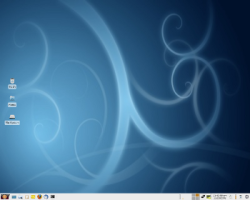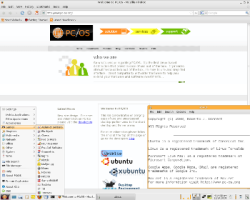Author: Preston St. Pierre
PC/OS aims to be an easy-to-use Linux distribution right out of the box. Being Ubuntu-based, it has a head start on being user-friendly, but PC/OS goes above and beyond Ubuntu’s measures to ensure ease of use by having common third-party non-GPL software included in the install.
The PC/OS distribution comes in several different flavors: OpenServer, OpenWorkstation, and OpenDesktop, all of which weigh in at around 700MB and fit on one CD. Included with the server edition are Webmin and other GUI utilities to make various server operations easier. The workstation edition includes multimedia production tools, software development tools, and office tools. I tested the desktop edition, which focuses on everyday use.
Like many distributions, PC/OS boots into a live CD which you can use without installation, or you can install it to your hard drive at boot time. The install is simple. It asks you which user name and password to use. You can choose manual disk partitioning, or let PC/OS handle that automatically. All of the software on the CD is automatically installed without user selection required. Near the end of the install you are given the option of importing users from other Linux installs on the same system; I chose not to. The install took about 25 minutes on my AMD Sempron 2800+ with 512MB of RAM, and when I rebooted I found it had properly detected all my hardware as well as providing a pop-up which installed the Nvidia drivers.
The PC/OS OpenDesktop CD image comes with several programs for completing various tasks under an Xfce desktop. Abiword and Gnumeric are the only included office applications, but there is a link in the Office section of the menu to Google Docs. You get the Firefox browser, Thunderbird for email, Pidgin for IM, Skype for VoIP, Transmission for BitTorrent, and Gnome PPP for the dial-up users. Asunder provides CD ripping, and Brasero CD burning. Exaile will play your music and VLC will play your videos. The GIMP stands alone as the only image editing software included, but when it comes to games, you can take your pick from among card games such as Solitaire, FreeCell, and BlackJack, as well as chess, mahjongg, Mines, Gnometris, and more. Wine is available to run Windows applications. Synaptic lets you add programs that aren’t included in the default install, with the default sources including the Ubuntu Hardy repository as well as various other smaller repos.
PC/OS notably includes the Java Runtime Environment, Adobe Flash Player, and proprietary multimedia codecs. Many self-proclaimed user-friendly distributions fail to include these due to philosophical or legal issues, but their lack can result in massive headaches for mom-and-pop users who don’t know how to manually install them.
PC/OS Open Desktop lives up to its claims of being user-friendly. While it isn’t perfect, somebody who is unfamiliar with computer systems could install and use it without outside help. I don’t believe that you can say the same thing about the latest Windows operating system. On top of that, it also fits on one CD, unlike many distributions which have switched to DVDs in their effort to include more software. PC/OS has stripped its distribution down to programs that cover users’ essential needs; its simplicity is a sound principle when designing user-friendly software.
PC/OS just plain worked for me. There were no hitches, no problems, and no additional configuration or software installation required to perform what the daily tasks of Web browsing, instant messaging, word processing, and playing multimedia. While no trouble arose for me, there are forums available for you to ask any questions you might have about the distribution.
PC/OS may not include any remarkable new software, but that is not its goal. Instead, it provides an excellent starting point for people who have never used Linux and want to see what it is like. It will show them exactly how easy it can be to use Linux.
Categories:
- PC/OS
- Reviews
- Linux
- Distributions





